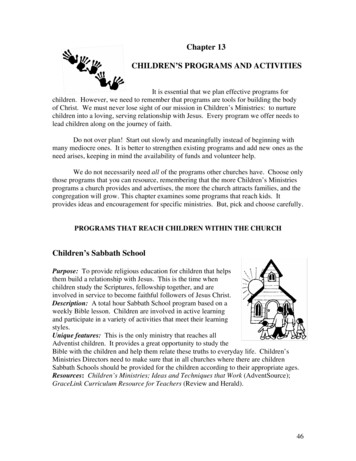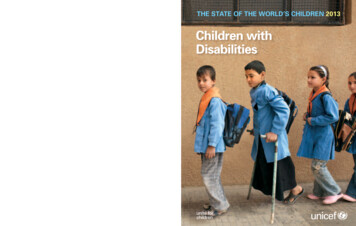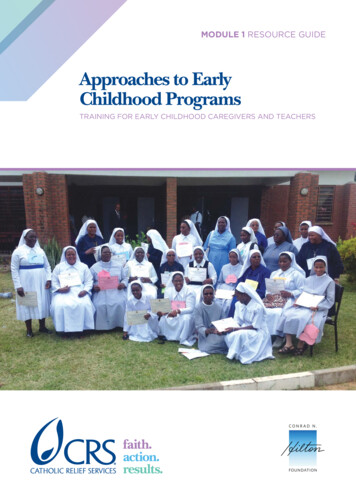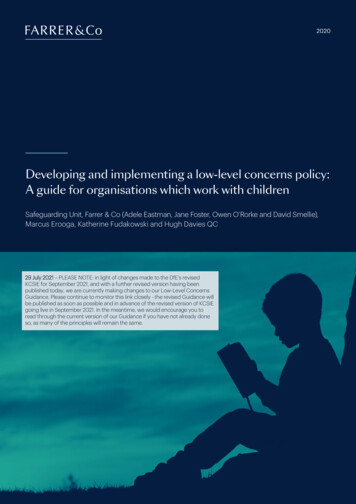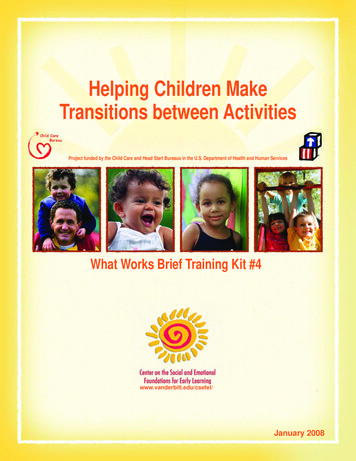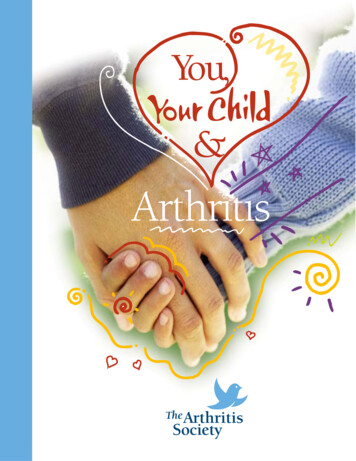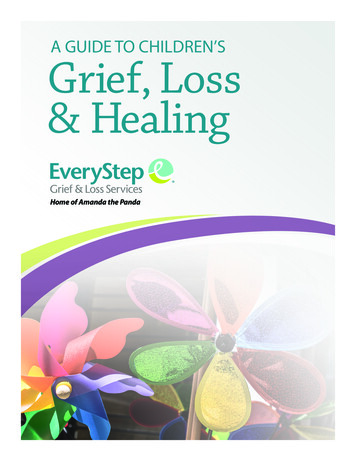
Transcription
A GUIDE TO CHILDREN’SGrief, Loss& Healing1(515) 223-4847 everystep.org
A GUIDE TO CHILDREN’SGrief, Loss & HealingTable of ContentsDevelopmental Responses to Grief. 3What Children, Adults and TeachersNeed to Know About Grief. 7Explaining Death to Children. 8Grief vs. Depression in Children.14How to Help a Grieving Child.15Bereaved Children.17How to Help a Grieving Teen.20Supporting Grieving Siblings.22Talking with Kids about a Death from Addiction.24Parents: How to Talk to Kids about Suicide.26Supporting Children and Teens after a Suicide.28Returning to School after a SuicideLoss: For Teens.32Tips for Teachers Following a Suicide.33Programs and Services.351(515) 223-4847 everystep.org
Developmental Responses to GriefWhile everyone grieves differently, there are some behaviors and emotions commonly expressed by childrendepending on their developmental level. No matter how old a child is, it can be helpful to read through eachof the age ranges, as there are times when a six year old asks a complex, big picture question and thosewhen a teenager is struggling to find a physical outlet for their grief. We hope this information will help withunderstanding how grief affects children and teens across the developmental span.AGES 2-4 YEARS OLDDevelopmental StageChildren this age don’t fully understand that death is permanent and universal. They are most likely to expressthemselves through their behavior and play.Concept of DeathYoung children see death as reversible and are starting to wonder if death happens to everyone. You mighthear questions like: “My mom died? When will she be home?” and “Will you die too? What about me?”Common responses to grief General anxiety/ heightenedseparation anxiety Crying Denial Withdrawal Irregular sleep/fear of sleep Clinginess/ need to be held Irritability Temper tantrums Telling the story to anyone, includingstrangers Repetitive questions Behavior regression- may need helpwith tasks they’ve already learnedEXPECT: Withdrawal, denial,Ways to help Assure adult protection and care Provide physical comforts: rest, holding, routine Create a consistent routine to re-establish safety and predictability,especially around starting and ending the day. Provide a short, honest explanation of the death. “Mommy died,Her body stopped working.” Use the words dead and died. Avoideuphemisms such as gone, passed on, lost. Explain physical reality of death Answer questions honestly. Set limits but be flexible when needed. Provide opportunities for play. Give choices whenever possible. “Do you want hot or cold cereal?” Offer lots of physical and emotional nurturance. Give repeated concrete explanations Encourage teacher/parent communication Enrich “feeling” vocabularyre-enactment play, heightenedseparation anxiety, whining, crying,clinging, tantrums, regression, andfear of sleep3(515) 223-4847 everystep.org
AGES 5-8 YEARS OLDDevelopmental StageChildren this age are exploring their independence and trying tasks on their own. They are very concrete thinkers,with a tendency towards magical/fantasy thoughts.Concept of DeathIn this age range, children often still see death as reversible. They can also feel responsible and worry that their wishesor thoughts caused the person to die. They may say things like: “It’s my fault. I was mad and wished she’d die.”Common responses to grief Disrupted sleep, changes in eating habits Repetitive questions - How? Why?Who else? Concerns about safety and abandonment Short periods of strong reaction, mixedwith acting as though nothing happened Nightmares Regressive behaviors- may need helpwith tasks they’ve already learned(can’t tie shoes, bedwetting) Behavior changes: high/low energy,kicking/hitting Physical Complaints: stomachaches,headaches, body pain Poor academic performance Peer problemsEXPECT: Poor academic performance,Ways to help Provide realistic information; address magical thinkingEncourage appropriate acting outContinue to enrich feelings vocabularyEncourage verbal and creative expressionProvide opportunities for age-appropriate tasksProvide opportunities for physical activityExplain the death honestly using concrete language. “Daddy’s heartstopped working.” Use the words dead and died. Avoid euphemismssuch as gone, passed on, lost.Be prepared for repetitive questions.Provide opportunities for big energy and creative play.Allow children to talk about the experience and ask questions.Offer lots of physical and emotional nurturance.Give choices whenever possible. “Your room needs to be cleaned.Would you like to do it tonight or tomorrow morning?”Normalize feelingsReduce academic requirementsProvide opportunities to help others in needfantasy play, obsessive talking aboutincident, anxious arousal, behavioralchanges, peer problems, psychosomaticcomplaints, attention seeking.4(515) 223-4847 everystep.org
AGES 8-12 YEARS OLDDevelopmental StageElementary school age children may still be concrete thinkers, but are beginning to understand abstract ideas likedeath and grief. They often start making closer connections with friends and activities outside their home and family.Concept of DeathChildren this age begin to understand that death is permanent and start thinking about how the loss will affect themover the long-term. Some children will focus on the details of what happened to the body of the person who died.Feelings of guilt and regret can lead to concern that their thoughts and actions made the death happen. They maysay or think things like: If I had done my homework, my teacher wouldn’t have died.” Or “I think it was my faultbecause I was mean to my brother.”Common responses to grief Express big energy through behaviorsometimes seen as acting out Anxiety and concern for safety ofself and others- “The world is nolonger safe.” Worries about something badhappening again Difficulty concentrating and focusing Nightmares and intrusive thoughts Physical complaints: headaches,stomach aches, body pain Using play and talk to recreatethe event Detailed questions about deathand dying Wide range of emotions: rage,revenge, guilt, sadness, relief,and worry Hypervigilance/ increased sensitivityto noise, light, movement, and change Withdrawal from social situations Fear of repetition of event happeningagainWays to help Inform yourself about what happened. Answer questions clearlyand accurately. Even though children this age are starting to graspabstract thought, it’s still helpful to use the words dead and diedand avoid euphemisms such as gone, passed on, lost, expired. Provide a variety of activities for expression: talk, art, physicalactivity, play, writing. Help children identify people and activities that help themfeel supported. Maintain routines and limits, but be flexible when needed. Give children choices whenever possible, “Would you rather set thetable or put away the dishes after we eat?” Work to re-establish safety and predictability in daily life. Model expressing emotions and taking care of yourself. Be a good listener. Avoid giving advice (unless they ask for it),analyzing, or dismissing their experiences. Seek professional help for any concerns around self-harm orsuicidal thoughts Normalize feelings and fears Reduce academic requirements Talk about relationship between acting out and traumatic event Provide opportunities to connect to larger community5(515) 223-4847 everystep.org
AGES 13-18 YEARS OLDDevelopmental StageTeens are cognitively able to understand and process abstract concepts about life and death. They begin to seethemselves as unique individuals, separate from their role in the family and may wrestle with identity and who theywant to be in the world. There can be significant changes in their priorities, spirituality/faith, sexuality, and physicalappearance. Teens often rely on peers and significant others outside the family for support.Concept of DeathWhile teens understand death is permanent, they may have unspoken magical thoughts of the person being on a longtrip, etc. They may also delve into questions about the meaning of life, death, and other traumatic events.Common responses to grief Withdrawal from family or othersupport networks/focused onconnections with peers Increased risk taking: drugs/alcohol,unsafe behaviors, reckless driving Inability to concentrate (schooldifficulties)/pushing themselvesto succeed and be perfect Difficulty sleeping, exhaustion Lack of appetite/eating too much Unpredictable and at times intenseemotional reactions: anger, sadness,guilt, relief, anxiety Uncomfortable discussing the deathor their experiences with parentsand caregivers Worry about safety of self and others Fear about death or violencehappening again Confusion over role identity in the family Attempts to take on caregiving/parent role with younger siblingsand other adults May have thoughts of suicide andself-harm Hypervigilance/increased sensitivityto noise, movement, lightWays to help Reinforce assurances of safety and security, even if teens don’texpress concerns. Maintain routines and set clear expectations, but be flexiblewhen needed. Allow for expression of feelings without trying to change, fix,or take them away. Answer questions honestly. Provide choices whenever possible. “I’d like to do something to honor yourdad’s birthday, would you like to be part of that? What ideas do you have?” Adjust expectations for concentration and task completionwhen necessary. Assist teens to connect with support systems, including other adults(family, family friends, teachers, coaches). Model appropriate expressions of grief and ways to take care of yourself. Ask open ended questions (“What is it like for you?”) and listenwithout judging, interpreting, advising, or placating. Have patience with teens’ wide range of reactions and questions. Seek professional help for any concerns around self-harm orsuicidal thoughts. Encourage physical activity Normalize feelings and fears Encourage group discussion Reduce academic requirements Resume routine activities when possible Talk about relationship between acting out and the traumatic event Discuss safety measures Provide opportunities to connect to larger communityEXPECT: Acting out, self-criticism, fearof repetition of event/happening again,displaced anger, guilt, andwithdrawal6(515) 223-4847 everystep.org
What Children, Adults, and TeachersNeed to Know About GriefWhat Children Need to Know.What Teachers Need to Know(Possible School Reactions) They are not alone. It’s okay to ask for help. Their world has been completely changed and willnever go back to the way it was. It’s normal to be afraid, to cry, to feel lonely and tobe angry. It’s okay if a caretaker cries when being asked questions. It’s okay to feel that life is unfair. They can trust the adults around them. Grief is a family matter. They are loved just as much as before the death. Become the class clown - Become withdrawn andunsociable Become restless in staying seated - Not completehomework - Become overly talkative Have problems listening, staying on task - Becomedisorganized - Show reckless physical action Show poor concentration around externalstimuli- Show difficulty in following directions Teachers can mistake a student’s healthy expression ofgrief- talking, crying, etc. as “having problems with aloss”, when this is normal for up to 2 years after a loss.Grief is not something that ends in a few weeks ormonths. Teachers can mistake a student’s lack of openexpressions of grief as “not really having any problemswith the loss.” Children learn to hide grief so they don’tstand out as weird or different at school. They alsocensor around adults to avoid upsetting them.What Adults Need to Know. You don’t need to have all the answers.You can’t “fix it” and make it all better.You can ask for help – from adults and children.Children will grieve, play, ask questions, and grieveagain in short spaces – be ready to respond whenthey’re ready to share!Children are not just small adults.Crying and questioning are healthy for all ages.Children/teens need to be with friends, to attendschool and be active.Children need reassurance that they did not causethe death.Children, teens and young adults need affirmationand support from adults.7(515) 223-4847 everystep.org
Explaining Deathto ChildrenAndrea Warnick RN, MA andCrossroads Charitable Foundation1. We’re afraid that we might not have all ofthe answers.As parents we aim to provide our children with securityand instill within them the knowledge that we willalways be there to care for them. When confrontedwith the subject matter of death, however, we oftenfind ourselves worrying whether or not we’ll be able toprovide our children with an answer that offers peaceand assurance.The death of a loved one is a life-changing experience.As adults, we have a lifetime’s worth of experiencehandling grief, disappointment, and all of life’s curveballs.Children, however, are mostly inexperienced when itcomes to handling difficult situations and emotions –especially the reality of a loved one’s death and theconcept of a death as a whole.Without guidance from an understanding adult, deathcan be confusing, overwhelming, and even a terrifyingconcept for a child. It falls to us parents, grandparents,guardians, and other significant adults/caretakers tounderstand how to best explain death to children inorder to provide them with a solid foundation whereina healthy understanding of the death and dying processcan be formed.You may not have all of the answers to all of yourchild’s questions, and that’s okay! You can be assured,however, that you will provide them a comforting,loving presence and be a bastion of security andcertainty for them during this difficult period.2. It can be difficult to talk to children — especiallyyounger children.When talking about a matter as complex as death, itcan difficult to know that we’re being heard by thechild, and equally difficult to understand a child’squestions and responses.Parents want to protect their children from emotionalpain and suffering. This natural parental instinct can bedifficult to balance with the desire to be honest andupfront about harsh realities; such as talking aboutdeath and dying. As a therapist who specializes inworking with grieving children, one of the most frequentquestions I’m asked is: “When is the right time to tellthe kids that a family member will likely die from thisillness?” While there is no “right time” that works for everyfamily, there is one certainty: children of all ages benefitfrom being prepared in advance for the deathof someone close to them.Adhering to honest, short answers throughout yourexplanation, as well as in your responses to questionscan help simplify matters for the child and ensure theygain an understanding of the concept and permanenceof death. When dealing with younger children, it canbe especially prudent to favor explanations of deathas the inability to perform life functions-like breathing,eating, and moving.Why is Explaining Death to ChildrenSo Difficult?3. We’re afraid that we won’t be able to adequatelycomfort them or provide them the help thatthey need.After receiving the news of a loved one’s death andwhen beginning to understand the realities of death,children can display a wide range of reactions — withMany adults feel a great deal of anxiety when they thinkabout having to one day explain the concept of deathto a child. Why, though, do adults feel uneasy when wethink about discussing death with our children?8(515) 223-4847 everystep.org
When Is the Best Time to Talk to aChild about Death?some emotions seeming numb and disconnected,while other children can display large outburstsof emotion.Many of us may consider keeping painful truths, suchas the death of a loved one, hidden from children in aneffort to protect them. In practice, however, this onlyserves to prolong a period of uncertainty and anxiety inchildren, who have a keen ability to pick up on subtleemotional changes in adults and in the home.Understand that, during this time, your child needs tofeel whatever he or she feels. Regardless of their initialreaction to the concepts of death, you will be able tobe their comforter and stable foundation during thisdifficult period.Though the desire to shield your child from the painfulnews of a death is grounded in good intentions, toprevent unnecessary anxiety and emotional anguishin your child, the sooner you are able have theconversation about death with your child, the better.4. We may be dealing with our own grief at the time.We may be coping with our own grief around thesame time we’re attempting to explain death to ourchildren. When coping with grief, many shy away frompotentially showing sadness and emotional vulnerabilityin front of their children, for fear of showing weaknessor making the children feel afraid or insecure.Determining timingEven when caregivers are convinced they need to behonest about an impending death, deciding when toshare this heartbreaking news with children can be adaunting task. Some times are certainly better thanothers for telling children (dropping them off at school isdefinitely not a good time). For most families, the “righttime” will always be hard to determine. It rarely feels“right” to share such information, especially in the caseof a dying parent or sibling. The task is always difficultemotionally and often feels opposite to what parentsthink they should do.Know that it’s okay to be processing your grief at thistime, and it’s important for your child to see that you’reprocessing your emotions and sharing them honestly— not bottling them up and ignoring them. Lettingyour child see you work through your emotions willlet them know that it’s okay to feel sad, angry, or feelany other emotion that may come as a result of aloved one’s death.5. Death is often a taboo topic.Death and the dying process are topics that we heavilyavoid as a society. Death was once regarded as anormal part of family life, with deaths most oftenoccurring at home and among family. Now, the dyingare very much a separate body from mainstreamsociety; as such, we’re now uneasy in even mentioningthe word “death” in conversation, defaulting to morecomfortable euphemisms such as “lost,” or “passed away.”But there are some strategies families can use to helpthem decide when to share this information. These include: Ask children to describe what they already know aboutthe situation. Many caregivers are surprised to learnthat some children have already considered thelikelihood of the loved one dying. Reassure children that talking about the likelihoodof death does not increase the chances of the deathoccurring. Children often engage in “magical thinking.”This can make them feel responsible for good and badoutcomes, despite not actually having any controlover them. Providing children with facts and concreteexplanations can help them focus on things that areactually within their control (such as how to spendtime with their family member). Knowing what toexpect can help them let go of things beyond theircontrol (such as worrying about when the personwill die).Regardless of social taboos, it’s best to promotehonesty and reality when explaining death to yourchild. Using gentler euphemisms to describe death,while well-intentioned, often confuse children. Yourdedication to communicating openly and honestlywith your children about death with serve them wellas they begin to formulate their understanding andrelationship with the concepts of death and dying.9(515) 223-4847 everystep.org
Ask children how much information they want. Dothey want a lot of information or just a summary ofthe most important information? Some children needmore information than other children and benefit frombeing told about the prognosis as soon as possible.It’s also important to let children know that they canchange their minds later on if they would like more orless information. Create an environment where children feel safe askingquestions. Adults can invite children to ask anyquestions they have about the illness, even the hardquestions. Children may ask: “Could Dad die fromhis cancer?” It’s important to answer such questionshonestly. Keep in mind it can be a relief for childrento hear that adults may not have all the answers totheir questions. Adults can provide reassurance thateven though they do not have all the answers it is stillimportant to talk and wonder about these hard thingstogether. Recognize that it’s unnecessary to hold off tellingchildren until “all of the medical information” isobtained. Many families think they shouldn’t talk tochildren until they have more information (more testresults, a more accurate prognosis). But children andyouth can appreciate being a part of the experienceof uncertainty with the adults in their life. Ask the physician directly for an estimation as tohow long the person will live. If the death may beimminent, it’s important to share that informationwith children right awayMany families are pleasantly surprised to find that childrentend to resume their regular activities and interestsquite quickly after learning a parent or sibling may die.Children possess a remarkable ability to balance deepjoy and deep sorrow. As well, parents often feel greatlyrelieved once this information is out in the open. Theyno longer need to spend energy on trying to control theflow of information.Yet knowing someone will die and actually experiencingthe death can be two very different things. Children andyouth may still be shocked or surprised when a familymember dies, even if they’ve been well preparedbeforehand.How to Prepare for the Conversation1. Understand what your child will be able tocomprehend about death at their age.By understanding what your child will be able tograsp before you have the conversation, you canstructure your explanation to fit their ability tocomprehend the information. Infants can grasp that the adults in their life are sador angry, but cannot understand the concept of death. Preschoolers may see death as a reversible,non-permanent event and may invent magicaltheories as to what causes death and what isrelated to the dying process. Elementary School-aged children understandthe permanence of death and understand thecorrelation of events that lead to someone’s dying;however, death is often perceived as an event thatsolely happens to other people. Middle School-aged children have a full understandingof the physical aspects of death and its finality;however, some abstract concepts surroundingdeath and dying may be beyond their reach. High School-aged children have a full understandingof death and dying, its finality, and the impact of adeath on the lives of themselves and others.Some families are open with their children about thelikelihood of death from the time of diagnosis. This isan approach that works well for many children. PhyllisSilverman is Project Director of the Harvard/MGH ChildBereavement Study and author of Never Too Young toKnow: Death in Children’s Lives. She writes:[t]elling them the truth from the beginning sets the stagefor an openness that needs to be there throughout theillness and afterward. When they are involved in this way,they will always be certain that they are part of thefamily. They will know that there are no family secretsthat isolate them from each other and that do not honorwhat they see, what they know, and what they feel. (p. 80)2. Know what to avoid when discussing death withyour child.Avoid euphemisms such as “passed away” or “waslost.” These terms can turn your explanation awayfrom the realities of death and can be very confusingor frightening, especially for younger children.10(515) 223-4847 everystep.org
Don’t chastise your child for crying or displayingsadness and vulnerability. Phrases such as “suck it up,”“toughen up,” “you’re the man/woman of the housenow”, or “be a big kid” can be very damaging andhave long-lasting effects on a child’s outlook on deathand overall emotional health.3. Set up the environment where you will have theexplanation.Select an area that is comfortable, familiar, andallows for direct, one-on-one communication.Providing a safe space where children are free toexpress themselves and any emotions that maycome over them is key.Ensure the room is free from the distraction ofcomputers, televisions and other electronicdistractions that may divide their attentionduring the conversation.Keeping your answers short, simple, and free of unnecessarydetails can helps children absorb your explanation andkeeps the pathway open for future communication.3 keys to remember when explainingdeath to your childWhile your child’s age and personality will play a largerole in dictating what information is appropriate anduseful when discussing death, incorporating the followinginto your explanation will help you inform your child andpromote an environment of open communication.1. Be honest and encourage questions.During your explanation, let your child know that it’sokay to ask any questions that might come to mind.You may not feel that you have all of the answersas an adult, but that’s okay — you can respond to aquestion with an honest “I’m not quite sure about that.”Children benefit from honest informationTelling children in advance about the potential deathof a family member or friend is beneficial because it: fosters an environment of open and honestcommunication enables children to get information from caregivers leaves less opportunity for children to imaginedifferent or inaccurate explanations helps children make sense of the physical changesthey see happening to a person who is unwell creates an opportunity for the ill person to play arole in preparing children for the possibility of hisor her death allows time to put additional support systemsin place, such as school counselors and griefprograms, where available enables children to grieve with the adults in theirlives, instead of alone and from the sidelines.Caregivers can help children understand thattheir emotions and those of others around themare healthy and natural gives children the chance, when the death of aloved one is imminent, to say goodbye in a waythat feels appropriate for them, or to just be withthe person with a shared knowing that their timetogether (at least physically) is limited enhances the trust between children and theirprimary caregivers.Having toys, such as dolls, playset pots and pans,coloring books, and other playthings present in theroom are quite beneficial in helping your child absorbyour explanation. Play is the work of children and hasbeen shown to be a therapeutic force for childrenwhen receiving information that is emotionallydifficult to process.Having the Conversation: Explaining Deathto Your ChildYou can use the following tenets as a general templatefor framing your explanation about death, and adjustit in accordance with what you feel will best serve yourchild’s needs.Provide a simple, honest explanation of death.When explaining death, particularly to younger children,it’s best to use simple terms that don’t shy away from thereality of death and its permanence. Addingunnecessary details or using long, drawn-outexplanations can cause a child to stop askingquestions altogether, as they often simply don’twant to listen to that much talking.“Everything that lives, one day dies. Death is the end ofliving. When someone dies, their body stops working;they don’t need to eat, drink, or breathe anymore. It’sis not like sleeping. Once someone dies, they are deadforever and cannot come back.”11(515) 223-4847 everystep.org
Withholding information can create challengesMost children and youth can sense when adults arewithholding information, which can cause them toworry more. When information is withheld, childrenmay learn about an impending death only byoverhearing conversations not intended for theirears. Or they may hear it from people outside theimmediate family. Children really benefit from learningof such news directly from their parents or guardiansbefore hearing it from others. It can be difficult, if notimpossible, for parents to control the flow of informationoutside the family. Therefore, the sooner parentsopen up conversations about dying with their kids,the less likely kids are to learn such upsetting newselsewhere.There is a trust issue as well. If children discover thattheir parents or guardians knew about a loved one’simpending death but intentionally didn’t tell them,they may have difficulty trusting their caregivers inthe future. This creates additional challenges in thechildren’s grief process.Honesty helps prepare children for lifeWhen parents choose not to inform children of animpending death in the family, they usually have thebest of intentions. Often, they are just trying toprotect their children from emotional pain. Inaddition, facing one’s own mortality or dealingwith the potential death of a family member takesa tremendous emotional, physical, and spiritual, tollon an individual. This makes finding the best wayto support children that much more of a challenge.Many parents fear they will say something that“makes things even worse.” It’s important for parentsto be compassionate toward themselves during thistime while reminding themselves that the bestprotection for t
grief- talking, crying, etc. as “having problems with a loss”, when this is normal for up to 2 years after a loss. Grief is not something that ends in a few weeks or months. Teachers can mistake a student’s lack of open expressions of grief as “not really having any problems with the loss.” Ch
